

When it’s time to reach for the jam, reach for the best. We nibbled our way through dozens of artisan-made jams to find them for you. Photo by N. Joy Neish | BSP.
|
STEPHANIE ZONIS is a contributing editor.
|
|
June 2006
Updated December 2008
|
 |
The Best Strawberry Jams & Preserves
Page 2: The Difference Between Jam, Jelly & Preserves
This is Page 2 of a seven-page article. Click on the black links below to visit other pages.
The Difference Between Jam, Preserves, Jelly, Etc.
How are fruit preserves made, and what’s the difference between a jelly, jam, preserve, marmalade and conserve?
- Traditional fruit preserves of all types are made from fruit mixed with sugar and pectin. Pectin is a fiber occurring naturally in the cell walls of most fruits. When heated in water, if the correct quantities of sugar and acid are present, pectin will form a colloidal solution that gels, or thickens, upon cooling. If a fruit is too low in pectin, as is the strawberry, pectin can be added in powdered or liquid form, or the strawberry can be combined with another fruit higher in this fiber.
Now, about the differences between fruit preserves:
- Jellies are made only from the juice of fruit, and they are typically the stiffest type of fruit preserves.
- As a rule, a jam is a thick puree, made from fruit pulp or crushed/mashed fruit.
- Preserves are similar to jams, except that they consist of chunks of fruit (or even whole fruit) in a thickened syrup (for the sake of convenience, the terms “preserves” and “jam” are used interchangeably throughout this article).
- Traditionally, marmalades are preserves, but they’re citrus-based.
- And a conserve is a jam made from a blend of fruits. Conserves usually contain some form of citrus, as well as nuts and/or raisins (many contain alcohol, as well).
Read our more extensive glossary of jams and jellies and related terms.
|
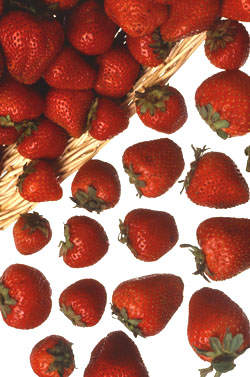
Whether jelly, jam or preserve, great products start with great fruit. Photo by Scott Weller courtesy of U.S. Agricultural Research Service. |
Note that these terms tend to be technicalities; many manufacturers of jam refer to their product as a preserve, and vice versa. Not infrequently, products seemed like hybrids of the two categories, with big chunks of fruit in thick purées.
There’s far more that must be considered when one is making jam or preserves than just nomenclature, of course.
- The correct level of acidity is important in making a jam or preserve (a pH of about 3.1 is ideal). If there is too much or too little acid, the spread will not thicken properly, or it may “weep,” an occurrence known as “syneresis.” In cases where fruits lack natural acid (and, believe it or not, strawberries are such a fruit), acidity can be increased to proper levels through the addition of lemon juice or other citrus fruits.
- Conveniently, commercial pectins of the type often added to a strawberry jam or preserves usually contain acids that help to ensure a proper pH and, hence, gelling. Manufacturers take some liberties with their formulations; some don’t add pectin or lemon juice (or either). There’s nothing wrong with that, but it can result in a jam with a thinner consistency, unless the spread is cooked for a much longer time. It’s up to you to decide how thick you like your preserves.
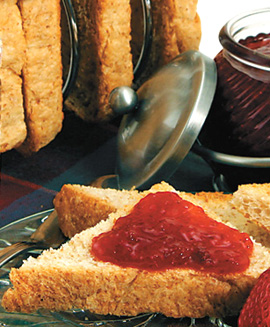
One of our favorite great food finds in this article are these Strawberry and Grand Marnier Preserves from Prince Edward Island Preserve Company. So good, they take us back to the days when people ate preserves plain for dessert.
|
In a traditional jam or preserve, sugar assists in gel formation, acts as a preservative and, of course, adds sweetness. Levels of sweetener (and the type of sweetener used) can be as important to a preserve as levels of acidity and pectin. Too much sugar can yield a stiff, sticky jam, or, conversely, one that refuses to “set”; too little can encourage mold growth. In contrast to the Colonial era in the U.S., sugar is now cheaper than fruit, and has been for many decades. In the early 20th century, some manufacturers sold jams and preserves that consisted of little more than fruit-colored, gelled sugar syrup. As a result, for many years now, the FDA has had strict standards regarding minimum quantities of fruit in fruit spreads. For strawberries, not less than 47 parts fruit (by weight) are mandated for 53 parts sugar (again, by weight). |
When making jams or preserves, it’s important to combine fruit, pectin and sweetener in the proper order. If the fruit and sugar are combined before the pectin is added, the pectin might not hydrate properly and a proper gel won’t be achieved. Other potential problems include, but are not limited to, crystal formation in the finished product, bubbles (these may denote nothing more than the fact that air became trapped in the hot product, but they may also indicate spoilage), cloudiness, darker than normal color, a product that is tough or stiff, shriveled-looking fruit or lack of a characteristic fruit flavor. None of this considers filling and sealing the jars of preserves, a critical step for any manufacturer. Sterilized jars and lids and a tight seal are crucial for shelf life. Unlike with cheese, where one can just scrape off the mold and enjoy the cheese, most authorities today are adamant that mold growing on a jam renders it unsafe to eat; scraping off the mold and eating the rest of the jar can be hazardous to your health! Consequently, manufacturers whose products sit on store shelves for any length of time must be very concerned with keeping their products and processes aseptic.
Cooking With Strawberries
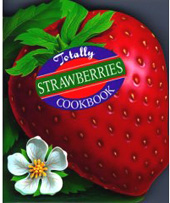 |
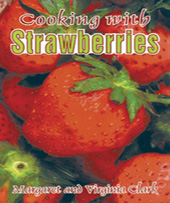 |
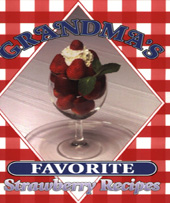 |
| Totally Strawberries Cookbook, by Helene Siegel and Karen Gillingham. One of the popular “Totally...Cookbook” series, a diverse collection of recipes, each delicious and easy to make. Highly recommended for all strawberry lovers. Click here for more information or to purchase. |
Cooking With Strawberries, by Margaret and Virginia Clark. You don’t have to have a strawberry patch like the Clarks, but if you love strawberries, you can share their collection of 120 recipes for fresh or preserved strawberries. Click here for more information or to purchase. |
Grandma’s Favorite Strawberry Recipes, by Lanette Coalson. An exceptional cookbook filled with more than 150 taste-tested selections, from nostalgically traditional to the temptingly elegant. Click here for more information or to purchase. |
Continue To Page 3: The Sugar Level In Jam
Go To The Article Index Above

|









